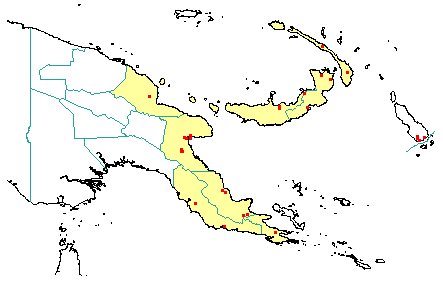
in PNGplants database
PNGTreesKey – Celtis latifolia (Blume) Planch. |
Barry Conn (NSW) & Kipiro Damas (LAE).
Guide to trees of Papua New Guinea
Copyright held by the authors, National Herbarium of New South Wales, and Papua New Guinea National Herbarium
Prodromus Systematis Naturalis Regni Vegetabilis, Sive Enumeratio Contracta Ordinum Generum Specierumque Plantarum Huc Usque Cognitarum, Juxta Methodi Naturalis Normas Digesta Vol. 17: 186 (1873)
Other Literature: E. Soepadmo, Flora Malesiana, Series 1 63 (1977) Fig. 20-23.
Family: Cannabaceae
Dicotyledon
Timber Group: Commercial hardwood
Field Characters: Large canopy tree (up to 30 m high); Bole cylindrical (c. 50 cm diam.); straight (bole 14- 25 m long); buttresses buttresses present; spines spines absent; aerial roots aerial roots absent; stilt roots stilt roots absent; Bark dark grey or pale brown, slightly rough or smooth, finely fissured, pustular, or finely tessellated, lenticels elongated laterally or lenticels rounded/swelling; Subrhytidome (under-bark) yellow, green, or mottled; less than 25 mm thick, 10.0; bark blaze consisting of one layer; strongly aromatic; pleasant; outer blaze pink or pale brown, speckled, granular without splinters; inner blaze pink or pale brown, speckled, granular without splinters; bark exudate (sap) present, colourless, not readily flowing (spotty), colour changing on exposure to air, to pale brown, not sticky; terminal buds not enclosed by leaves.
Indumentum: Complex hairs absent; stinging hairs absent; mature twig indumentum (hairs) present or absent, hairs sparse.
Leaves: Leaves spaced along branches, spiral (leaves occurring singly at a node and arranged spirally up the branchlet), simple (a leaf composed of a single blade); petiole present, not winged, attached to base of leaf blade, not swollen; leaves broadest at or near middle or broadest below middle, (8.0-) 15.0-18.0 (-25.0) cm, (6.0-) 8.0-12.0 (-18.0) cm; very asymmetric or symmetric, entire, not dissected or lobed, rounded or acute to acuminate, venation trinerved, secondary veins open, prominent, intramarginal veins absent; leaves lower surface pale green, upper surface green, indumentum (hairs) absent to present, indumentum (hairs) sparse; absent; domatia absent; stipules present, free (peltately attached), laterally placed, not encircling the twig, leafy, not fringed, large, persistent.
Flowers: Inflorescence axillary, flowers on a branched axis, cones absent; flowers unisexual, unisexual with male and female flowers on the same plant, stalked, flowers with many planes of symmetry, 1.5-3.0 mm long, diameter small (up to10 mm diam.); perianth present, with all sepals and/or petals (hence tepals) similar, inner perianth pale yellow or cream-coloured; 5, free; stamens 5, present, free of each other, free of the perianth; ovary superior, carpels joined (when more than one), locules 1; styles absent.
Fruits: Infrutescence arranged on branched axis, fruit 15.0-25.0 mm long, orange or pale red, not spiny, fleshy, simple, indehiscent, drupe; seeds 1, to about 5 mm long, not winged, broad (as wide as long), seed 1-10 mm diam. (c. 5 mm diameter).
Distribution: Madang, Morobe, Central, Northern, Milne Bay, New Britain & New Ireland.
 | Botanical records in PNGplants database |
Notes: Notes The genus Celtis was previously classified in the separate family Ulmaceae.